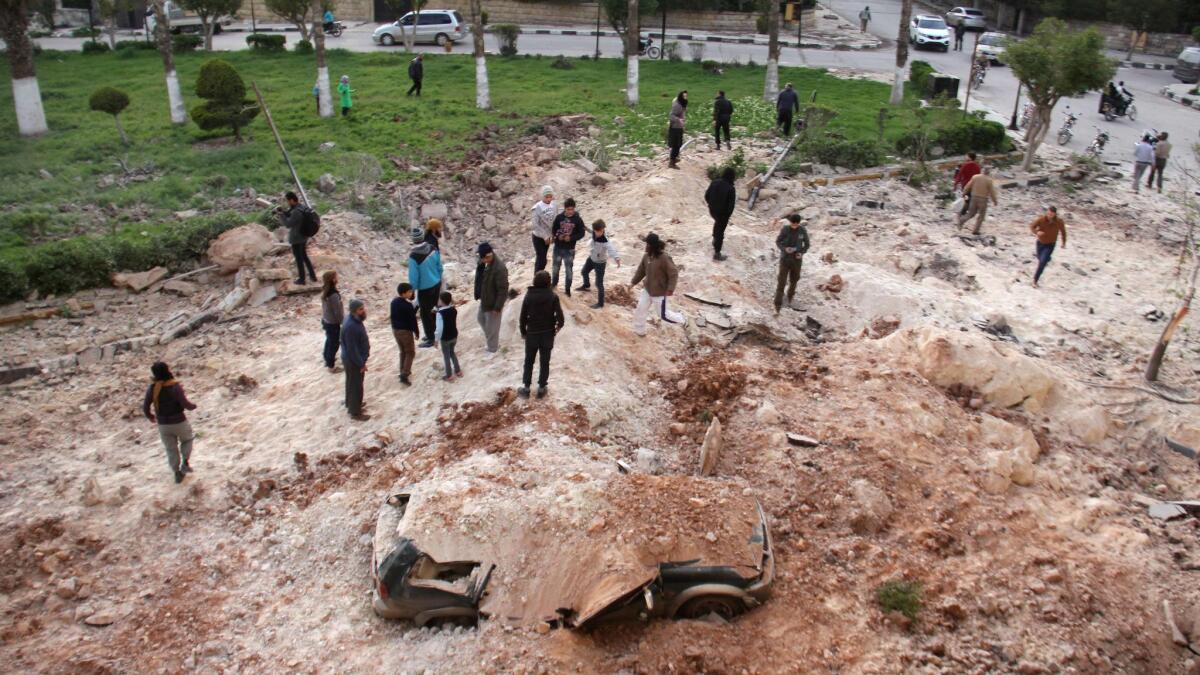Syria’s government helped create a rebel bastion — then attacked it with poison gas, the U.S. says

Reporting from Amman, Jordan — When the Syrian government dropped what the U.S. says were chemical munitions this month in the northwestern province of Idlib, it was targeting a rebel bastion that it helped create.
For months, the Russian-backed Syrian army had been recapturing Aleppo and other major cities — and giving the defeated rebel fighters safe passage to the province.
Through reconciliation deals, roughly 31,000 rebels and 75,000 of their relatives and other civilians have wound up there. Idlib became the main bastion of resistance to President Bashar Assad.
The province has also been a top destination among the millions of people who have been displaced in the civil war, with the United Nations estimating that at least 110,000 people fleeing violence elsewhere in the country came to Idlib in recent months.
Opposition groups say the alleged chemical attack, which reportedly killed more than 80 people, is part of an all-out attempt by the government to wipe out its opponents now that so many are in the same place.
It followed months of bombardments by Syrian and Russian warplanes and helicopters, including nearly 1,000 strikes last month, according to the Syrian Observatory for Human Rights, a pro-opposition group that monitors the conflict.
“There’s been a major escalation here this year since the fall of Aleppo,” said Dhayf Allah Murr, a member of the pro-opposition local council in the village of Um Jalal, roughly 30 miles south of Idlib city. “We’re being struck day and night.”
“The skies are never empty. One aircraft leaves, and another comes right after.”
The U.S. government also considers Idlib a problem in that so many extremists are congregated there. In February, a U.S. missile killed Abu Khayr Masri, reported to be Al Qaeda’s second in command there.
The province of verdant farmlands and an estimated 1.8 million people — the vast majority of them Sunni Muslim — had been marginalized for decades by governments in Damascus, including that of Assad, whose Alawite sect is related to Shiite Islam.
When the uprisings against Assad began in 2011, people in Idlib were quick to join.
“Idlib is emblematic of the type of rural, conservative, Sunni Arab regions that have been the engine of the uprising,” Aron Lund, a fellow with the Century Foundation think tank, wrote in a report last year. “In these areas, the population is largely hostile to the army, and the rebellion has local roots that are, very often, much stronger than those of the government.”
In 2015, nearly the entire province fell to a coalition of hard-line Islamist groups that proceeded to destroy the buildings, statues, murals and other vestiges of Assad’s Baath Party there.
Idlib became a base for some of the president’s most implacable — and effective — adversaries, including Ahrar al Sham, one of the largest jihadi factions in the country, and the Organization for the Liberation of Syria, a former Al Qaeda affiliate once known as the Nusra Front.
To the frustration of the Syrian government, munitions and other materials to fight Assad flow directly into Idlib across the border with neighboring Turkey.
Control of the Bab al Hawa crossing has also been an important source of income for the rebels, generating up to $4.8 million a month in customs payments for Ahrar al Sham, according to the Aleppo Project research group.
That income has allowed the jihadists to work toward creating a quasi-state, commandeering or cooperating with local councils to maintain government services and impose elements of Islamic law, such as restrictions on what women can wear.
Rebels have also gained influence among the population in Idlib by controlling the the distribution of humanitarian aid from the United Nations and other groups.
With Idlib as their base, jihadist groups last month launched an offensive on the neighboring province of Hama — an advance that the U.S. says pushed the Syrian government to deploy chemical weapons.
The rebels have also continued to threaten Aleppo and Latakia, the Mediterranean coastal region that is the heartland of government support.
There were signs that the Syrian government was also planning to push back.
Assad, who regularly insists that his forces will “liberate every inch of the country,” said in an interview last year with the Russian newspaper Komsomolskaya that Idlib’s position near Turkey meant: “You cannot cut. You have to clean.”
“You have to keep cleaning this area and to push the terrorists to Turkey to go back to where they come from, or to kill them,” he said. “There’s no other option.”
And Ali Haidar, who as the minister of reconciliation was responsible for crafting the local truces that sent rebel fighters to Idlib, said in an interview with Reuters this year that “Idlib is one of the coming hot areas.”
Unless there were an international deal to diffuse the situation, the government planned “open battle” with the rebels there, he said.
Still, the government can afford to let the rebels linger awhile longer in Idlib, Lund said.
Syrian government forces “besieged the areas they really need to clear out — basically the big cities and the central territories, the places where the war will be won or lost, which is not Idlib.”
Bulos is a special correspondent.
ALSO
Pence warns North Korea not to ‘test’ Trump, says the ‘era of strategic patience is over’
Turkey’s Erdogan lashes out at West after disappointingly narrow victory
More to Read
Sign up for Essential California
The most important California stories and recommendations in your inbox every morning.
You may occasionally receive promotional content from the Los Angeles Times.











